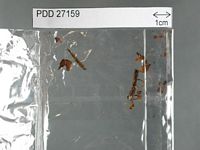|
 Flammulaster foliicola Flammulaster foliicola
BiostatusPresent in region - Indigenous. Endemic
Images (click to enlarge) | 
Caption: Dried type specimen
Owner: Herb PDD |
Article: Horak, E. (1980). Fungi Agaricini Novazelandiae. VIII. Phaeomarasmius Scherffel and Flammulaster Earle. New Zealand Journal of Botany 18(2): 173–182 (http://www.rsnz.org/publish/abstracts.php).
Description: Pileus -12 mm, hemispheric when young later becoming convex to plane; brown to dark soot-brown, fuliginous, aged specimens becoming grey-argillaceous; granular to minutely squamulose at disc, smooth towards striate margin; dry, hygrophanous, membranous, veil remnants absent. Lamellae (L 8-12, -3) moderately crowded, adnate to adnexed, ventricose; pale grey-brown at first, turning pale fuliginous with age, edge albofimbriate. Stipe -15 x -1 mm, cylindric, equal, central; concolorous with pileus, whitish-pruinose at apex; dry, hollow, single in groups, basal tomentum absent, veil remnants none. Context brown. Odour not distinctive. Spores 6.5-8 x 4-5 µm, distinctly limoniform, pale brown, membrane thin-walled, smooth, germ pore absent. Basidia 20-26 x 5-6 µm, 4-spored. Cheilocystidia 40-55 x 5-8 µm, fusoid, neck elongated, apically rounded, membrane thin walled, hyaline or pale brown, clamped at basal septum. Pleurocystidia absent. Caulocystidia like cheilocystidia. Cuticle composed of irregularly arranged chains of ovoid to subglobose hyphae (5-13 µm diam.), terminal cells clavate or broadly fusoid, membrane not gelatinised, encrusted with brownish pigment. Clamp connections present.
Habitat: On rotting leaves of Cordyline indivisa Sieud.(Agavaceae). New Zealand.
Notes: Microscopically this species can be mistaken for F. pulveraceus Horak, a common species of Flammulaster in New Zealand. However, the two related agarics are distinguished by the fuliginous colour of the carpophores and the smaller spores in F. foliicola, recorded once on rotting leaves of cordyline indivisia (cabbage-tree).
|